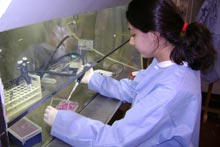Kamelia Ghazi L&S Sciences
Investigation of the Genetic Mechanism by which Curcumin Achieves the Hypoacetylation of Histone
Curcumin (CUR), the active chemical of the Asian spice tumeric, has a strong anti-oxidant, anti-inflammatory effect in preventing neurodegenerative diseases like Alzheimers (AD), as well as an anti-proliferative effect on cancerous cells. Based on broad ranges of scientific literature on this topic, CUR has correlated with dramatic reduction in acetylation of histone. However, the precise mechanism by which curcumin achieves hypoacetylation and therefore represses the transcription of cancerous cells, is poorly understood. In this experiment, I will culture C6 rat glioma cells and through using immunostaining and protein assay, I will quantitatively monitor the proliferation and differentiation of neuroglial cells with different doses of CUR. Hopefully, this research will provide further explanations of CURs preventive-therapeutic role in wide ranges of neurodegenerative diseases.
Message To Sponsor
Doing research is one of the intellectually rewarding activities that stimulates my personal and thought development by raising countless questions in my mind, and motivating me to find answers to those questions. Having the financial support that allows me to concentrate on research without interruption is a key to success. The SURF program achieves just that. SURF will enable me to cultivate a productive research experiment during the summer by guaranteeing that the major portion of my time is protected for laboratory investigation without being worried about the financial burden. With this award, I will be able to acquire the additional knowledge, skills, and experience needed to lighten my career path and catalyze my social and intellectual growth.